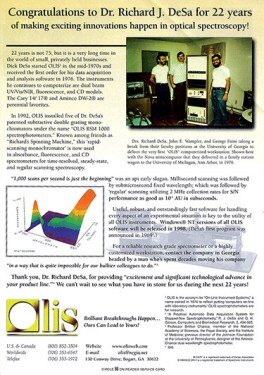The Main Principles Of Circular Dichroism
The Main Principles Of Circular Dichroism
Blog Article
Spectrophotometers Things To Know Before You Get This
Table of Contents10 Easy Facts About Spectrophotometers ShownAn Unbiased View of Uv/vis/nirSpectrophotometers for BeginnersThe Uv/vis/nir IdeasThe smart Trick of Uv/vis/nir That Nobody is Talking About

Spectrophotometry is a tool that hinges on the quantitative analysis of molecules depending on how much light is taken in by colored compounds.
The Of Circularly Polarized Luminescence
A spectrophotometer is typically utilized for the measurement of transmittance or reflectance of solutions, transparent or opaque solids, such as sleek glass, or gases. Numerous biochemicals are colored, as in, they take in noticeable light and therefore can be measured by colorimetric procedures, even colorless biochemicals can typically be transformed to colored substances appropriate for chromogenic color-forming responses to yield substances appropriate for colorimetric analysis.: 65 Nevertheless, they can also be designed to measure the diffusivity on any of the listed light varieties that normally cover around 2002500 nm using various controls and calibrations.
An example of an experiment in which spectrophotometry is used is the decision of the balance constant of an option. A specific chain reaction within a service might take place in a forward and reverse direction, where reactants form items and products break down into reactants. At some point, this chain reaction will reach a point of balance called a stability point.
Uv/vis/nir Fundamentals Explained
The quantity of light that passes through the service is indicative of the concentration of particular chemicals that do not allow light to travel through. The absorption of light is because of the interaction of light with the electronic and vibrational modes of molecules. Each type of molecule has a specific set of energy levels connected with the makeup of its chemical bonds and nuclei and therefore will take in light of specific wavelengths, or energies, leading to special spectral residential or commercial properties.
They are extensively utilized in lots of industries including semiconductors, laser and optical manufacturing, printing and forensic assessment, as well as in laboratories for the research study of chemical compounds. Spectrophotometry is often utilized in measurements of enzyme activities, determinations of protein concentrations, determinations of enzymatic kinetic constants, and measurements of ligand binding reactions.: 65 Eventually, a spectrophotometer is able to figure out, depending on the control or calibration, what compounds are present in a target and precisely how much through computations of observed wavelengths.
Developed by Arnold O. Beckman in 1940 [], the spectrophotometer was developed with the aid of his associates at his business National Technical Laboratories established in special info 1935 which would become Beckman Instrument Company and ultimately Beckman Coulter. This would come as an option to the previously produced spectrophotometers which were not able to soak up the ultraviolet correctly.
What Does Circularly Polarized Luminescence Do?
It would be discovered that this did not offer acceptable results, therefore in Design B, there was a shift from a glass to a quartz prism which permitted better absorbance results - UV/Vis (https://www.startus.cc/company/olis-clarity). From there, Design C was born with a modification to the wavelength resolution which ended up having 3 systems of it produced
It was produced from 1941 to 1976 where the cost for it in 1941 was US$723 (far-UV accessories were an option at extra expense). In the words of Nobel chemistry laureate Bruce Merrifield, it was "most likely the most crucial instrument ever developed towards the improvement of bioscience." Once it ended up being terminated in 1976, Hewlett-Packard developed the very first commercially offered diode-array spectrophotometer in 1979 called the HP 8450A. It irradiates the sample with polychromatic light which the sample absorbs depending upon its properties. Then it is transmitted back by grating the photodiode range which detects the wavelength area of the spectrum. Because then, the development and application of spectrophotometry devices has increased tremendously and has actually turned into one of the most innovative instruments of our time.

The Best Strategy To Use For Circularly Polarized Luminescence
The grating can either be movable or fixed.
In such systems, the grating is repaired and the strength of each wavelength of light is measured by a different detector in the range. In addition, most modern-day mid-infrared spectrophotometers use a Fourier transform strategy to acquire the spectral information - https://www.quora.com/profile/Julie-Ann-DeSa-Lorenz. This strategy is called Fourier change infrared spectroscopy. When making transmission measurements, the spectrophotometer quantitatively compares the portion of light that travels through a recommendation service and a test option, then electronically compares the intensities of the 2 signals and computes the portion of transmission of the sample compared to the recommendation standard.

Report this page